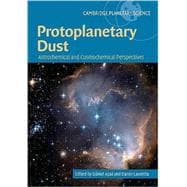
Note: Supplemental materials are not guaranteed with Rental or Used book purchases.
Purchase Benefits
What is included with this book?
| List of contributing authors | p. xi |
| Preface | p. xv |
| Acknowledgments | p. xviii |
| Planet formation and protoplanetary dust | p. 1 |
| Types of extraterrestrial material available | p. 2 |
| Chronology of planet formation | p. 6 |
| Protostellar collapse | p. 8 |
| Structural evolution of protoplanetary disks | p. 9 |
| Chemical evolution of the gas disks | p. 11 |
| Laboratory dust analogs | p. 12 |
| Dust composition in protoplanetary disks | p. 13 |
| Dust coagulation | p. 14 |
| Thermal processing of the pre-planetary material | p. 15 |
| Dispersal of protoplanetary disks | p. 17 |
| Accretion of planetesimals and rocky planets | p. 18 |
| Key challenges and perspectives | p. 19 |
| The origins of protoplanetary dust and the formation of accretion disks | p. 27 |
| Dust in the interstellar medium | p. 28 |
| Presolar grains in primitive Solar System materials | p. 40 |
| Star formation | p. 52 |
| Evolution of protoplanetary disk structures | p. 66 |
| Some properties of protoplanetary disks | p. 67 |
| Protoplanetary disk structure and evolution | p. 70 |
| Particle dynamics | p. 80 |
| Protoplanetary disk dynamics and dust evolution | p. 85 |
| Summary | p. 92 |
| Chemical and isotopic evolution of the solar nebula and protoplanetary disks | p. 97 |
| Protoplanetary disks | p. 99 |
| Chemical constraints from early Solar System materials | p. 110 |
| Isotopic anomalies and condensation sequence | p. 111 |
| Oxygen isotopes | p. 113 |
| Summary | p. 122 |
| Laboratory studies of simple dust analogs in astrophysical environments | p. 128 |
| Dust-analog synthesis | p. 131 |
| Characterization techniques | p. 136 |
| Dust processing | p. 140 |
| Grain-growth studies | p. 143 |
| Grain-catalysis studies | p. 149 |
| Conclusion | p. 155 |
| Dust composition in protoplanetary disks | p. 161 |
| Modeling the dust composition | p. 162 |
| Laboratory studies of Solar System dust | p. 164 |
| Dust composition in Solar System samples | p. 166 |
| Remote sensing of dust around young stars and in comets | p. 170 |
| Composition of the dust | p. 177 |
| Processing history of grains as derived from the dust composition | p. 185 |
| Dust particle size evolution | p. 191 |
| Dust coagulation in the Solar System and in extrasolar protoplanetary disks | p. 192 |
| Nomenclature and definitions | p. 193 |
| Coagulation basics | p. 196 |
| Laboratory simulations of dust coagulation | p. 197 |
| Observational tracers of grain coagulation | p. 198 |
| Chondritic meteorites | p. 206 |
| What do chondrite matrices tell us about the grain size of nebular dust? | p. 214 |
| Dust coagulation: how and when? | p. 217 |
| Constraints on dust coagulation from amorphous silicates | p. 219 |
| When did dust coagulation occur? | p. 221 |
| Astronomical versus meteoritic constraints | p. 223 |
| Thermal processing in protoplanetary nebulae | p. 230 |
| Thermal processing: annealing and evaporation | p. 231 |
| Observations of thermal processing in protoplanetary disks | p. 234 |
| Thermal processing in the Solar System: chondrites | p. 241 |
| Heating mechanisms | p. 250 |
| How would Solar System formation look to an outside observer | p. 256 |
| Promising future experiments | p. 257 |
| The clearing of protoplanetary disks and of the proto-solar nebula | p. 263 |
| The observed lifetime of protoplanetary disks | p. 263 |
| Disk dispersal processes | p. 274 |
| Our Solar System | p. 277 |
| Discussion | p. 288 |
| Accretion of planetesimals and the formation of rocky planets | p. 299 |
| Observational constraints on rocky-planet formation | p. 300 |
| Planetesimal formation | p. 304 |
| Growth of rocky planets | p. 312 |
| The effect of the giant planets and the formation of the Asteroid Belt | p. 321 |
| Summary | p. 328 |
| Common minerals in the Solar System | p. 336 |
| Mass spectrometry | p. 340 |
| Basics of light absorption and scattering theory | p. 343 |
| Glossary | p. 349 |
| Index | p. 363 |
| Table of Contents provided by Ingram. All Rights Reserved. |
The New copy of this book will include any supplemental materials advertised. Please check the title of the book to determine if it should include any access cards, study guides, lab manuals, CDs, etc.
The Used, Rental and eBook copies of this book are not guaranteed to include any supplemental materials. Typically, only the book itself is included. This is true even if the title states it includes any access cards, study guides, lab manuals, CDs, etc.